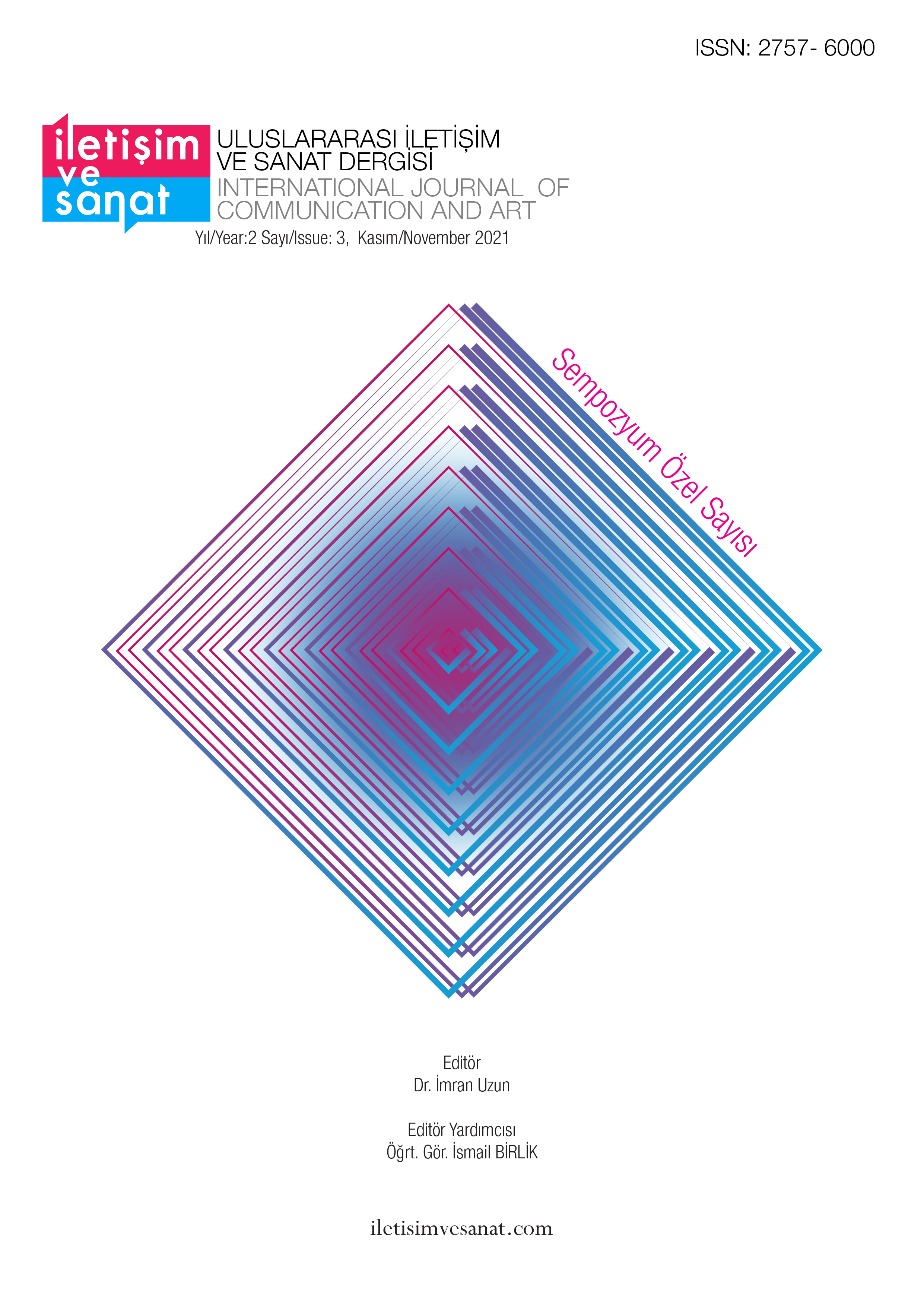Author :
Abstract
Günümüz sanatında mekânsal odaklı üretim pratikleri birçok sanatçının etkin şekilde kullandığı bir alandır. Sanatçıların mekâna özgü üretimleri, imgenin temsili nesneler ve algının bütüncül bağlamı ile şekillenmiştir. Mekânın mimari yapısı, kimlik, bellek, imge, görme, işitme, dokunma ve koku mekân algımızın bütüncül bağlamını oluşturan fiziksel ve duyumsal bileşenlerdir. Mekân algımızı güçlendiren duyusal deneyimler ortam odaklı sanatın temsil mekanları ile birlikte duyularımızı harekete geçirme yetisine sahiptir denilebilir. Böylece mekânın bütün bileşenleri ile algılanması kalıcı bir belleğin oluşmasına işaret eder.
Tarihsel referansları ile araştırmaya konu olan ortam odaklılık, mekân konusunda devrimsel bir düşünceye sahip olan Henri Lefebvre’nin kavramları üzerine inşa edilmiştir. Galeri ve müzelerden bağımsız, kamusal alanlarda sanatın yeniden inşası, hayatı ve sanatı yakınlaştırması Lefebvre’nin üzerinde sıklıkla durduğu bir konudur. Gündelik yaşam pratiklerimizin sosyal ve yaşamsal bütün unsurları toplumsal yaşama dahil olan mekanlarda geçer. Bu mekanlarda gerçekleşen, duyumsanabilen, ortam odaklı sanat üretimleri sanatçı- seyirci yakınlaşmasını sağlar.
Bu araştırmanın amacı mekâna özgü tasarlanan, duyusal deneyime ilişkin pratiklerin günümüz sanatında kurduğu bağlamı sanatçıların üretimleri ile ele almaktır. Belirtilen çerçevede ele alınan bu araştırma, Lefebvre’nin mekânın üretiminde kuramsallaştırdığı toplumsal mekânlar ile ilişkilendirilerek açıklanmıştır. Ayrıca kamusal verilerin mekâna taşındığı ve kamusal alanların sanatın temsil mekanlarına dönüştüğü çalışmalar incelenmiştir. Araştırma kapsamında literatür taraması yapılmış olup, kitaplar, internet kaynakları ve makalelerden yararlanılmıştır.
Keywords
Abstract
Site-specific production practices in today's art are an area that many artists use effectively. The site-specific productions of the artists have been shaped by the representative objects of the image and the holistic context of perception. The architectural structure of the space, identity, memory, image, sight, hearing, touch, and smell are the physical and sensory components that form the holistic context of our perception of space. It can be said that sensory experiences that strengthen our perception of space can activate our senses together with the representation spaces of site-specific art. Thus, the perception of the space with all its components indicates the formation of permanent memory. Sensory experiences that enhance our perception of space can activate our senses together with the representation spaces of site-specific art.
Site specification, which is the subject of research with its historical references, is built on the concepts of Henri Lefebvre, who has a revolutionary idea about space. Reconstruction of art in public spaces, independent of galleries and museums, bringing life and art closer is a subject that Lefebvre frequently emphasizes. All social and vital elements of our daily life practices take place in spaces that are included in social life. The art productions that can be felt and focused on the environment ensure the rapprochement between the artist and the audience.
This research aims to deal with the context of the practices related to sensory experience, which are designed specifically for the place, in today's art, with the productions of the artists. This research, handled within the specified framework, is explained by associating it with the social space Lefebvre theorized in space production. In addition, studies in which public data are transferred to space and public spaces are transformed into representation spaces of art are examined. Within the scope of the research, a literature review was made, and sourcebooks and articles were used.
Keywords
- Belting, H. (2020) Sanat Tarihinin Sonu. Ed. Ali Artun. İstanbul: İletişim Yayıncılık
- Belting, H. (2020) Sanat Tarihinin Sonu. Ed. Ali Artun. İstanbul: İletişim Yayıncılık Fizzel. M. (2017) Alison Knowles, Salad. 03 Eylül 2021 tarihinde
- https://www.feastingonart.com/2017/08/alison-knowles-salad.html adresinden alındı.
- Heintzelman, E. (2009). Understanding and Relationships in Community Space: A Study of Villages of Mariemont and Fairfax. Cincinatti: University of Cincinati.
- Lefebvre, H. (2010). Gündelik Hayatın Eleştirisi II. Işık Ergüden (Çev.). İstanbul: Sel.
- Lefebvre, H. (2014). Mekânın Üretimi. Işık Ergüden (Çev.). İstanbul: Sel. (Orijinal basım tarihi 1974, İngilizce basım tarihi 1991).
- Kwon, M. (2002) One Place After Another Site- Sipesific Art and Locational Identity. Cambridge/Massachussetts/London: The Mitt Press.
- Morris. L.G. (2019). How a Studio Uses The Senses To Spur Ecological Dialogue In AnExhibition Space. 07 Eylül 2021 tarihinde https://www.frameweb.com/article/how-a-studio-uses-the-senses-to-spur-ecological-dialogue-in-an-exhibition-space adresinden alınmıştır
- Nold. C. (2004). Bio mapping/ Emotion Mapping.12 Eylül 2021 tarihinde http://www.biomapping.net/index.htm adresinden alınmıştır.
- O’Doherty, B. (2010). Beyazın Küpün İçinde, Galeri Mekânının İdeolojisi. Çev. Ahu Antmen. İstanbul: Sel Yayıncılık
- Türkdoğan, T. (2014). Sanat Kültür Politika. Ankara: Nobel Yayın
- Yılmaz, M. (2005). Modernizmden Postmodernizme Sanat. Ütopya Yayınları. Ankara Yücel, D. (2012). Yeni Medya Sanatı ve Yeni Müze. İstanbul Kültür Üniversitesi.
